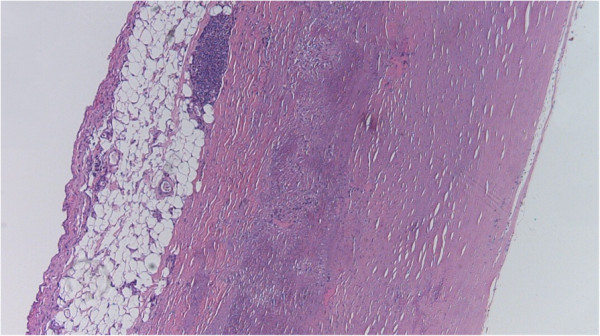Playlist
Show Playlist
Hide Playlist
Cerebral Infarct: Cerebral Vascular Accident (CVA)
-
Slides Complications of Atherosclerosis.pdf
-
Reference List Pathology.pdf
-
Download Lecture Overview
00:01 Okay, infarctions are not just the heart. 00:04 The heart is a great example, it's near and dear to my heart. 00:06 And it's what I do every day when I'm in the autopsy service. 00:11 But infarctions clearly can occur in any tissue. 00:14 And I'm just going to talk for a moment about cerebral infarction, cerebral vascular accident, CVAs, and stroke, which is the same thing. 00:23 And talk about why they occur, where they occur. 00:27 And to give you also a notion about collateral flow and other things. 00:30 So we're just looking at CT images demonstrating rather large temporal and, posterior infarcts in this individual, those are the areas that are black. 00:43 Okay. 00:45 So, if we think about the brain, and we're looking at the cerebrum, gray and white matter, grey matter peripherally white matter centrally, and we look at the cerebellum. 00:55 There are going to be different territories, depending on the blood supply. 00:59 So just the first vessel we'll talk about is the anterior cerebral artery, and the middle cerebral artery. 01:06 And they actually have collateral flow between them. 01:10 So if we have normal flow, that collateralization make sure that everything in between where the two vessels kind of they arborize in the middle, they're fine. 01:22 That brain gets consistent blood supply but if we have limiting flow, the zone in between is going to become a watershed zone. 01:32 So that if we have limiting flow to the anterior cerebral, limiting flow in the middle cerebral, in between where the collaterals would normally be kind of percolating through and making sure everyone's got a blood supply, then we would have diminished blood supply. 01:43 And we will get a watershed zone of infarction between those two collateralizing vessels. 01:49 So watershed zone is an important concept. 01:53 And in every tissue, there is a zone between major arteries, where the vessels kind of have little branches. 02:01 And if we have limiting flow to both of them, there will be a watershed. 02:04 Depending will occur in the heart, let's say between the left circumflex and the left anterior descending. 02:09 Okay, watershed zone infarcts. 02:13 Another part of the circulation in the brain are little penetrating arteries that come in to the kind of interface between the gray matter peripherally and white matter centrally. 02:24 And if I have limiting flow in those, then I will get laminar necrosis. 02:29 I will get specific necrosis that occurs in the neurons that are at that interface, It's just not getting enough flow. 02:37 So that's the point about that. 02:38 And then there are other parts of the brain that have for various reasons, increased susceptibility. 02:45 They have a greater metabolic demand even then they are typical neuron, and they will die more quickly if their blood supply is cut off. 02:52 And examples of that are the Purkinje cells of the cerebellum. 02:55 Purkinje cells are going to be the major integrating neurons responsible for allowing us to have kind of the integration of movement and balance and everything else. 03:05 They have a very high metabolic demand. 03:07 And a little bit of hypoxia, or a little bit of diminished blood supply, and you'll get specifically necrosis of the Purkinje cells before everything else dies. 03:17 Similarly, there's an area called Sommer's sector of the hippocampus where there's also a particularly susceptible subset of neurons. 03:25 So a little bit of hypertension, a little bit of ischemia, and that's enough to cause them to die. 03:31 So, where we get lesions in the brain depends on the vascular architecture, such as that anterior and middle cerebral artery collateralization. 03:40 The sensitivity of specific neuronal systems so the Sommer's sector and the Purkinje cells, and then their location, and that's the laminar necrosis. 03:49 And similar stories can be told for every other tissue.
About the Lecture
The lecture Cerebral Infarct: Cerebral Vascular Accident (CVA) by Richard Mitchell, MD, PhD is from the course Atherosclerosis.
Included Quiz Questions
Limited blood flow between two important collaterals in the brain can result in...
- ...a watershed zone of infarction.
- ...laminar necrosis.
- ...necrosis of Purkinje cells.
- ...necrosis of Sommer's sector.
- ...cerebrovascular lesion.
Purkinje cells of the cerebellum are an example of...
- ...an area that is particularly susceptible to cell death due to hypoxia and ischemia.
- ...a watershed zone of the infarct.
- ...laminar necrosis.
- ...a peculiar vascular architecture.
- ...a cerebrovascular lesion.
Customer reviews
5,0 of 5 stars
| 5 Stars |
|
5 |
| 4 Stars |
|
0 |
| 3 Stars |
|
0 |
| 2 Stars |
|
0 |
| 1 Star |
|
0 |




